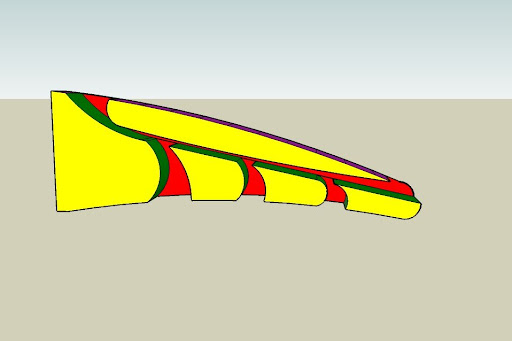- Login or Register
No account yet? Sign up

Ogami,Ogami musashi wrote:Conceptual: your design would be interesting but the problem is that the different holes result in mixing flow which means turbulent flows, so it would be pretty sensible inside the main channel.
If we think about an ideal case, were on the bottom of the nose you have high pressure, inside the main channel low pressure, and above low pressure, your system would provide for boundary layer suction on the bottom of the nose, and provided the pressure on the top of the nose is higher than in the channel (not guaranted) this would enhance downforce....BUT if for a reason (mixing flow, drag..) the pressures changes, like a stall in the main channel, the process is inversed. the main channel stalling will see its boundary layer sucked at the bottom of the nose which will increase the turbulence in this part, and the mixing with the top of the nose will provide lower pressure by boundary layer separation, then you have the inverse sitution with lift produced.
I also think the drag would be very big especially considering the shape and orientation of your "flute holes".
but who knows, maybe the idea is exploitable one day.
I guess I'm struggling to see what this design will do. From looking at the Ferrari cross section pics, it looks like the nose cone hole allows the air on the underside of the wing to stay attached for the full wing length before traveling up through the nose. Without the nose cone hole as relief, that air would have to divert around the whole nose cone section, and flow separation would occur much earlier on the wing, reducing downforce in that section.Conceptual wrote:Pics of my idea. Obviously not exact measurements, just conceptual.
The Fluted nosecone!
http://picasaweb.google.com/CKnopp/Conc ... 4TNfWzBQKA
Chris

I like it, and the email and included office suite is pretty nice as well!slimjim8201 wrote:Should work better now. Still trying to figure out the best way to have files hosted. Picasa's not bad...
Looks nice, what CFD software are you using and what type (file type) of models does it load? Things from SolidWorks, Pro-E and Inventor I assume?slimjim8201 wrote:More to come...

CFD software is CFdesign. We have special program for FSAE groups, if you don't have it already. Files from any CAD package are just fine. The big three are SW, Pro and Inv.alex1015 wrote:Looks nice, what CFD software are you using and what type (file type) of models does it load? Things from SolidWorks, Pro-E and Inventor I assume?slimjim8201 wrote:More to come...